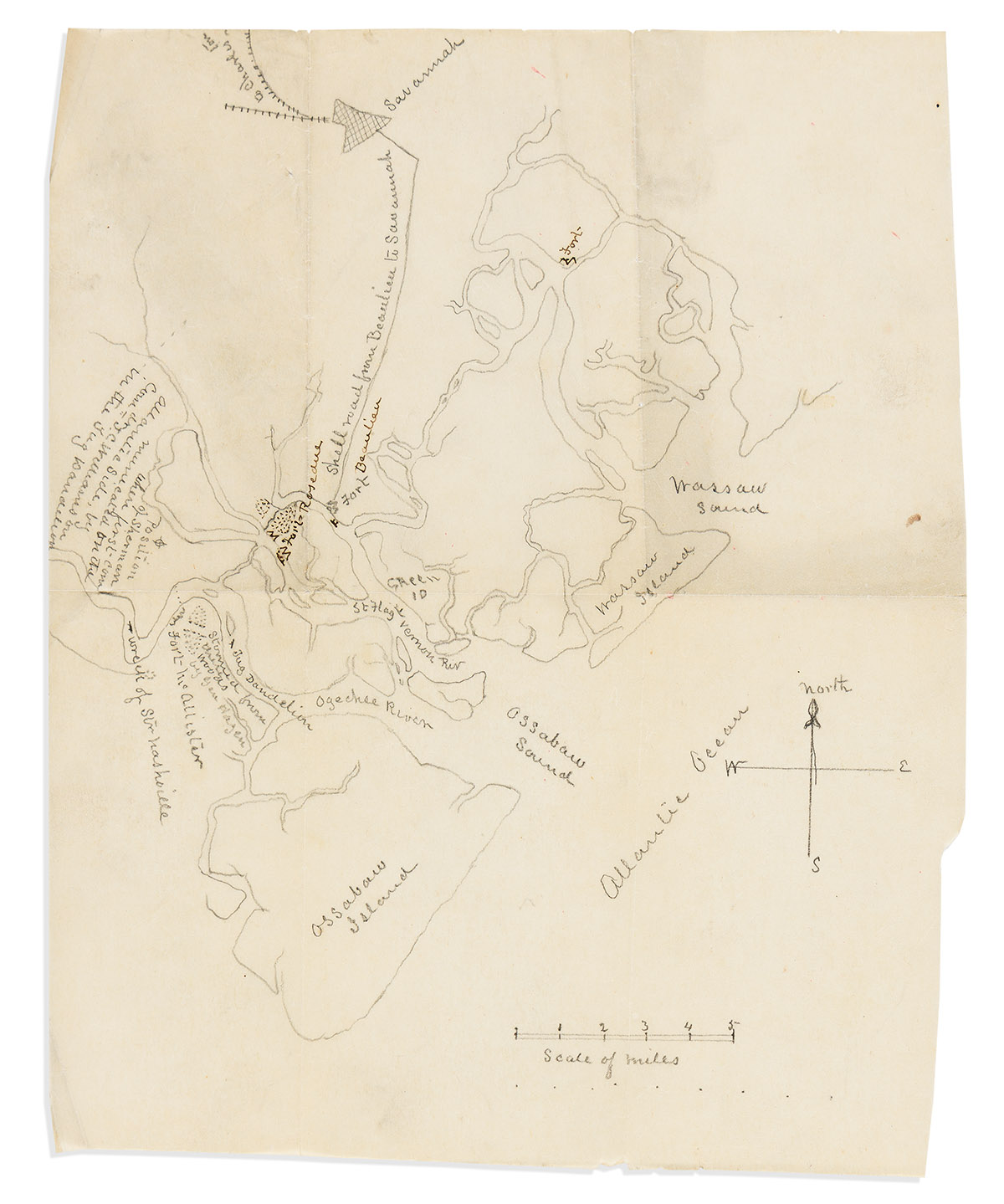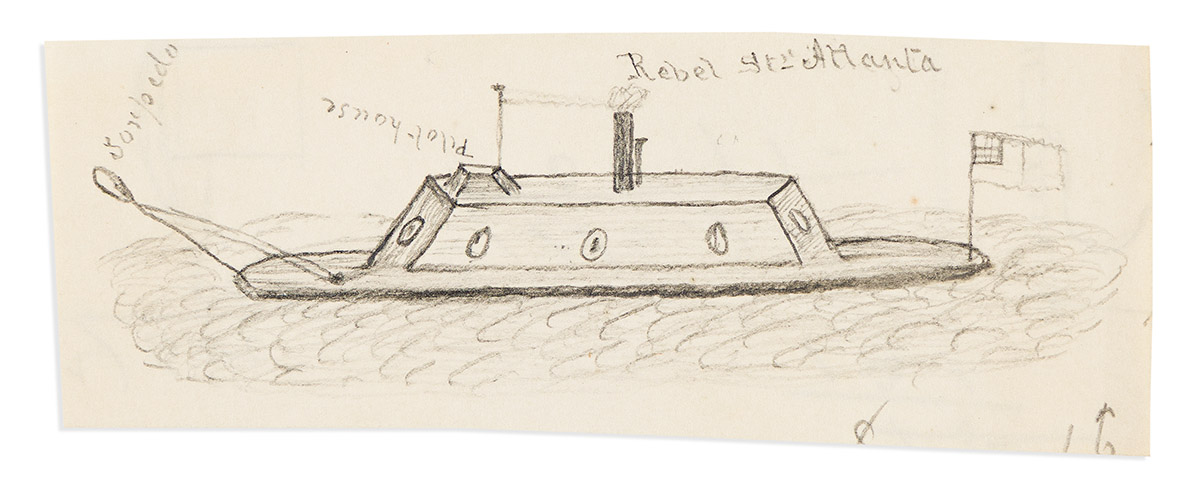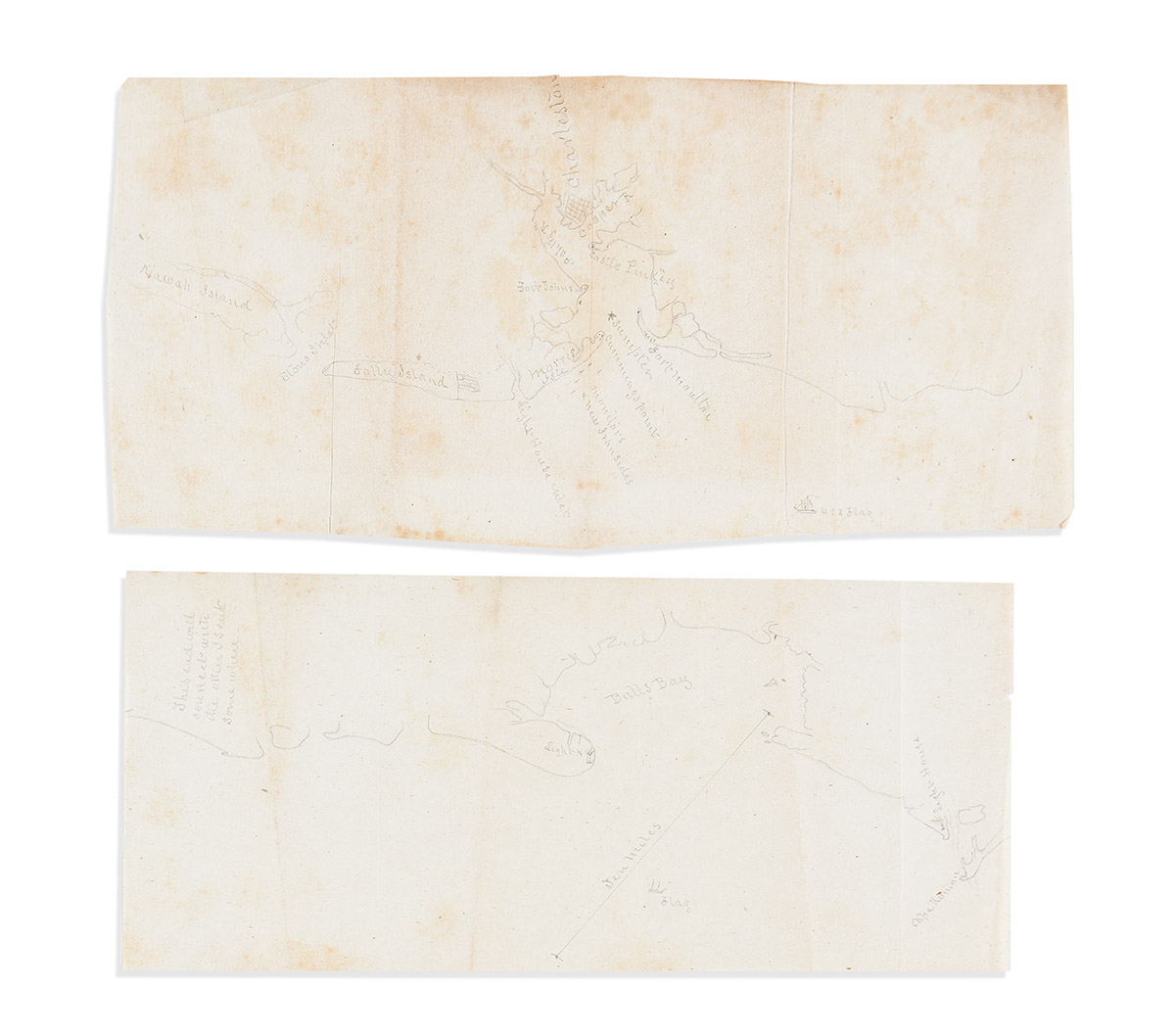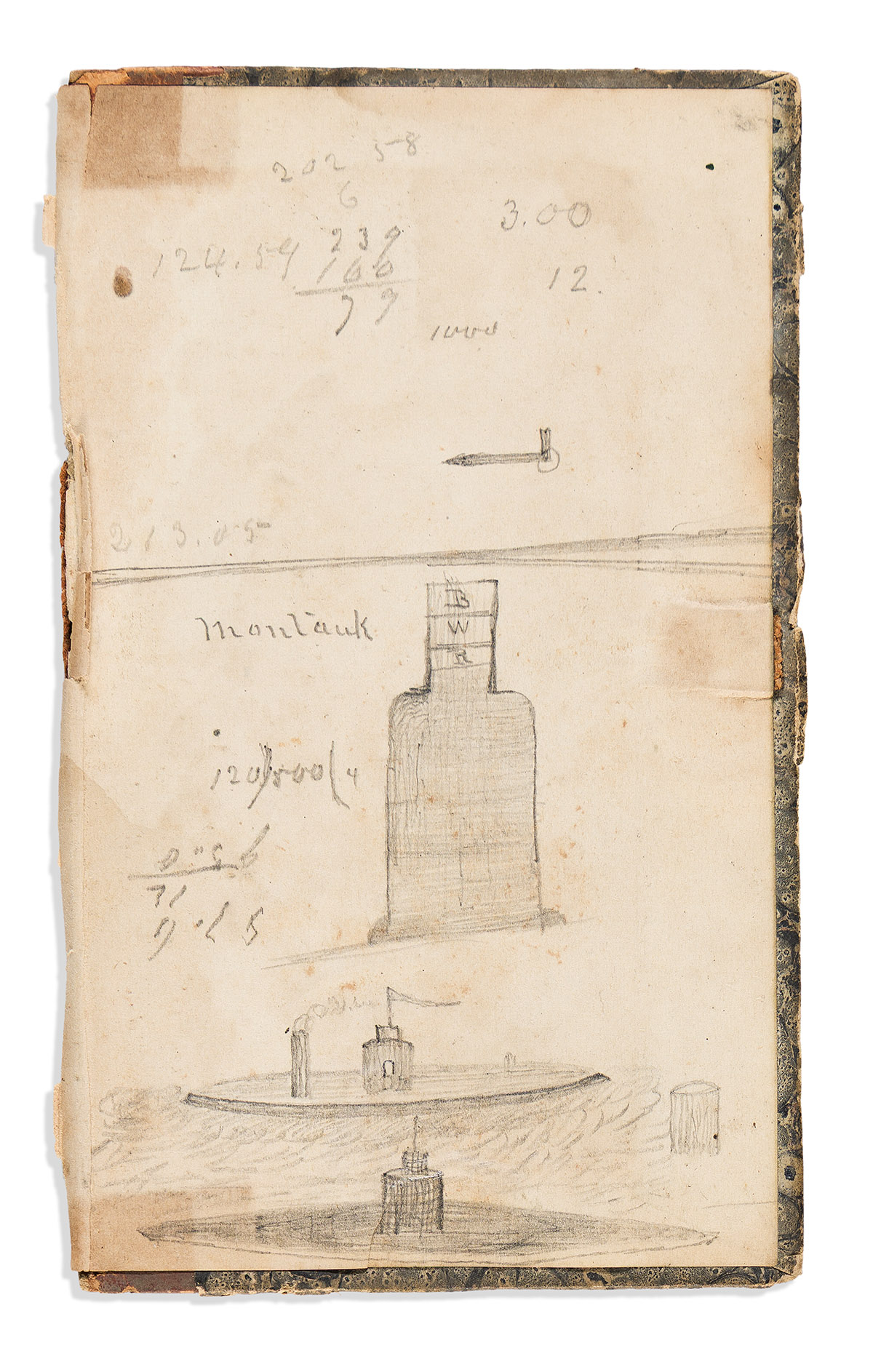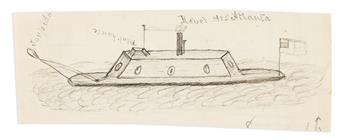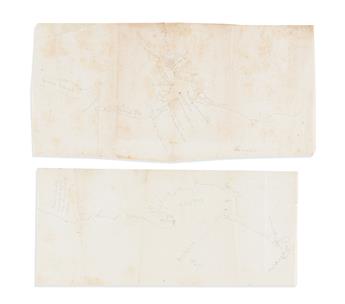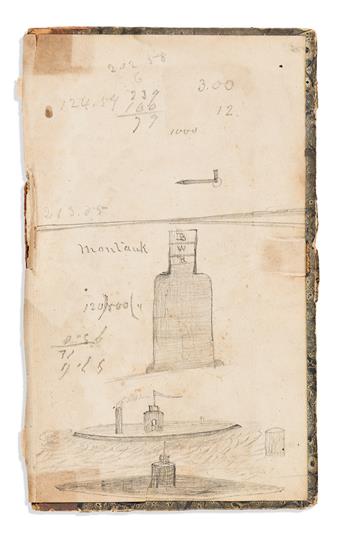Sale 2708 - Lot 69
Price Realized: $ 1,100
Price Realized: $ 1,375
?Final Price Realized includes Buyer’s Premium added to Hammer Price
Estimate: $ 2,000 - $ 3,000
(CIVIL WAR--NAVY.) Papers of naval captain, including manuscript maps of the Charleston and Savannah defenses, and monitor drawings. 9 items (3 maps, 4 letters, a memorandum book, and a small drawing) in one folder; minor wear except as noted. Various places, 1861-1865
Additional Details
James Cara Williamson (1813-1871) of Jersey City, NJ was a career naval officer going back to 1832. During the Civil War, he commanded the USS Flag on blockade from June 1863 until the close of the war. This lot includes:
A significant pencil coastline map of Charleston, 5 x 10½ inches, showing its defenses and the surrounding islands, including Forts Sumter and Moultrie. The site of Fort Wagner on Morris Island is not noted, but the American flag flies on nearby Folly Island, and Williamson's ship the USS Flag is shown anchored outside the harbor. Another shows the South Carolina coast north of Charleston, including Bull's Bay and Cape Romain, 10 x 4¼ inches.
A larger pencil map on tracing paper shows the Savannah, its coastline and its defenses, in pencil on tracing paper, 9½ x 7½ inches. The rail line to Charleston is noted, as well as a "shell road from Beaulieu to Savannah." Three forts are added in ink. Inland, we find a remarkable notation: "Position of Sherman where first communicated on the Atlantic side, by Comdr. J.C. Williamson in the tug Dandelion." The Dandelion's position is shown just a mile away. Sherman made contact with the Union Navy in December 1864.
Also included are 4 official letters addressed to Williamson. Two are dated from off Charleston on 7 July 1863, just before the Union army's assault on Fort Wagner. Captain Rowan of the USS New Ironsides requests that "as the monitors with their tows and other vessels will be arriving off Charleston during the night of Tuesday the 7th inst., you will please take such precautions as may be necessary to prevent their being fired into." Captain Green of the USS Canandaigua adds that "no signals have been arranged to distinguish them from other boats."
On 14 January 1865, we have a Letter Signed by Rear Admiral John A. Dahlgren, a month after the occupation of Savannah: "You will return to your anchorage in Ossabaw for the present. The comdr of the Para appears to be apprehensive of the batteries being re-occupied. . . . You will have the guns spiked and dismounted, the carriages removed or destroyed, the powder and shot or shell removed and the bomb-proofs and magazines blown up." Another Letter Signed by Dahlgren dated 7 February 1865 orders Williamson to "take charge of the cotton vessels belonging to the United States, now bound to New York. . . . Omit no precaution for the security of the convoy."
This lot also includes a worn 84-page notebook kept by Williamson from 1861 through 1865, with a long summary of his Civil War service, his personal cash accounts, a "slush fund" account, a list of generals headed by W.S. Sherman, and on the detached rear pastedown, three pencil views of the ironclad monitor warship USS Montauk. One is coded to show the distinctive black-white-red striping pattern on the turret, used to distinguish between these similar-looking ships. A separate slip of paper, 1½ x 4½ inches, has a pencil drawing of another ironclad, the CSS Atlanta, showing its flag, torpedo, and pilot house.
A significant pencil coastline map of Charleston, 5 x 10½ inches, showing its defenses and the surrounding islands, including Forts Sumter and Moultrie. The site of Fort Wagner on Morris Island is not noted, but the American flag flies on nearby Folly Island, and Williamson's ship the USS Flag is shown anchored outside the harbor. Another shows the South Carolina coast north of Charleston, including Bull's Bay and Cape Romain, 10 x 4¼ inches.
A larger pencil map on tracing paper shows the Savannah, its coastline and its defenses, in pencil on tracing paper, 9½ x 7½ inches. The rail line to Charleston is noted, as well as a "shell road from Beaulieu to Savannah." Three forts are added in ink. Inland, we find a remarkable notation: "Position of Sherman where first communicated on the Atlantic side, by Comdr. J.C. Williamson in the tug Dandelion." The Dandelion's position is shown just a mile away. Sherman made contact with the Union Navy in December 1864.
Also included are 4 official letters addressed to Williamson. Two are dated from off Charleston on 7 July 1863, just before the Union army's assault on Fort Wagner. Captain Rowan of the USS New Ironsides requests that "as the monitors with their tows and other vessels will be arriving off Charleston during the night of Tuesday the 7th inst., you will please take such precautions as may be necessary to prevent their being fired into." Captain Green of the USS Canandaigua adds that "no signals have been arranged to distinguish them from other boats."
On 14 January 1865, we have a Letter Signed by Rear Admiral John A. Dahlgren, a month after the occupation of Savannah: "You will return to your anchorage in Ossabaw for the present. The comdr of the Para appears to be apprehensive of the batteries being re-occupied. . . . You will have the guns spiked and dismounted, the carriages removed or destroyed, the powder and shot or shell removed and the bomb-proofs and magazines blown up." Another Letter Signed by Dahlgren dated 7 February 1865 orders Williamson to "take charge of the cotton vessels belonging to the United States, now bound to New York. . . . Omit no precaution for the security of the convoy."
This lot also includes a worn 84-page notebook kept by Williamson from 1861 through 1865, with a long summary of his Civil War service, his personal cash accounts, a "slush fund" account, a list of generals headed by W.S. Sherman, and on the detached rear pastedown, three pencil views of the ironclad monitor warship USS Montauk. One is coded to show the distinctive black-white-red striping pattern on the turret, used to distinguish between these similar-looking ships. A separate slip of paper, 1½ x 4½ inches, has a pencil drawing of another ironclad, the CSS Atlanta, showing its flag, torpedo, and pilot house.
Exhibition Hours
Exhibition Hours
Aliquam vulputate ornare congue. Vestibulum maximus, libero in placerat faucibus, risus nisl molestie massa, ut maximus metus lectus vel lorem.



